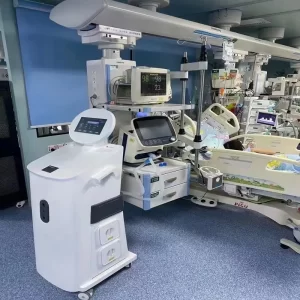Ventilator Internal Disinfection: Ensuring Clean and Safe Air for Improved Respiratory Health

We constantly think and practice corresponding to the change of circumstance, and grow up. We aim at the achievement of a richer mind and body along with the living for Ventilator internal disinfection.
Standing still today and searching into the long run, we sincerely welcome shoppers all around the globe to cooperate with us.
Introduction:
Ventilators play a crucial role in providing respiratory support to patients with compromised breathing. These life-saving machines assist individuals in breathing when their lungs are unable to function properly. However, ensuring the cleanliness and safety of the air delivered through ventilators is of paramount importance. In this article, we will delve into the significance of ventilator internal disinfection and explore the various methods to achieve it.
The Importance of Ventilator Internal Disinfection:
Ventilators are prone to the buildup of bacteria, viruses, and other harmful microorganisms over time. If not disinfected regularly, these pathogens can contaminate the air, leading to respiratory infections and complications. Regular disinfection helps eliminate these contaminants, ensuring clean and safe air for patients, and reducing the risk of hospital-acquired infections.
Effective Methods of Ventilator Internal Disinfection:
1. Manual Cleaning: Disassembling the ventilator components and manually cleaning them with approved disinfectants is a common method for internal disinfection. This process includes cleaning the tubing, filters, and other removable parts, followed by thorough drying before reassembly. It is crucial to follow the manufacturer's instructions and guidelines for safe and effective manual cleaning.
2. Automated Disinfection Systems: Many advanced healthcare facilities utilize automated disinfection systems specifically designed for ventilators. These systems employ sophisticated technologies like ultraviolet light, ozone, or hydrogen peroxide vapor to eliminate pathogens from the internal components. Automated disinfection systems can provide consistent and efficient disinfection, saving time and resources.
Expert Tips for Ventilator Maintenance:
1. Regular Cleaning Schedule: Establishing a regular cleaning schedule for ventilators is essential. This ensures that disinfection is performed at appropriate intervals, preventing the accumulation of harmful pathogens.
2. Proper Ventilation: Adequate ventilation in the room where the ventilator is used is crucial for maintaining air quality. Good airflow helps reduce the concentration of harmful particles and pathogens in the surrounding environment, making the disinfection process more effective.
3. Replacement of Filters: Ventilator filters play a vital role in removing particles, allergens, and microorganisms from the air. Regularly replacing these filters, following manufacturer's recommendations, is necessary to maintain optimal air quality.
Conclusion:
Ventilator internal disinfection is a critical aspect of maintaining clean and safe air for patients relying on these life-supporting machines. Regular disinfection, using appropriate methods such as manual cleaning or automated disinfection systems, is crucial in preventing respiratory infections and complications. Additionally, following expert tips for ventilator maintenance can further enhance the effectiveness of disinfection efforts, ensuring better air quality and respiratory comfort. By prioritizing ventilator internal disinfection, healthcare providers can significantly contribute to the improved respiratory health of their patients.
We have our own registered brand and our company is developing rapidly owing to high quality products, competitive price and excellent service. We sincerely hope to establish business relations with more friends from home and abroad in the near future. We look forward to your correspondence.